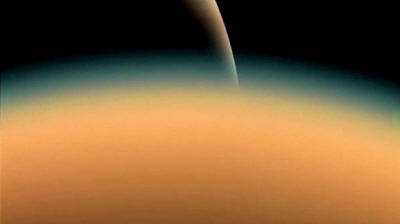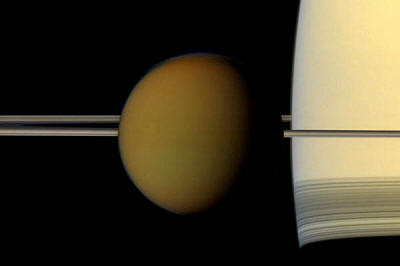|

by Pete Spotts
June 29, 2012
from
RawStory Website

A global ocean appears to lurk miles beneath the surface of Saturn's
moon Titan, adding to the allure of an object rich with the building
blocks of organic life and often likened to Earth before life
emerged.
Cassini has already found large lakes - most likely made of
hydrocarbons such as liquid methane - on Titan's surface.
But a team
of scientists using NASA's
Cassini spacecraft have now found
indirect but telltale signs of a subsurface sea, perhaps of water as
well as ammonia, which would act like antifreeze.
The data suggest that the ocean, perhaps more than 15 miles deep, is
sandwiched between two layers of ice, each less than 60 miles (100
kilometers) thick. It rides atop one layer of ice covering the
moon's rocky core and appears to be capped with another ice layer
that forms Titan's surface.
Titan has captured the imagination of scientists hunting for
potential habitats for simple forms of life for decades. The
temperature at Titan's surface is unbearably cold, minus 290 degrees
Fahrenheit. It is paved with the methane ices and other organic
solids on which Cassini's Huygens probe landed on Jan. 14, 2005.
Its
atmosphere is thought to mirror the composition of Earth's
atmosphere before the emergence of life some 3.8 billion years ago.

This image from
NASA's Cassini spacecraft shows Saturn's largest moon, Titan,
passing in front of
the planet and its rings.
A new study released
Thursday suggests there may be an ocean below Titan's frigid
surface.
(NASA/AP/File)
As hostile as the surface seems to be,
"liquids from below would
enhance the possibility of life being on the surface" as well as
enhancing the possibility of aquatic habitats deep beneath Titan's
crust, says Dirk Schulze-Makuch, an astrobiologist at Washington
State University in Pullman with a keen interest in Titan's
potential habitability.
Thursday's report represents "a nice step forward" in establishing
an ocean's presence on Titan, he says.
The new finding adds Titan to the growing list of moons thought to
have subsurface oceans. The icy surface of
Jupiter's Europa is
believed to hide a vast ocean, and data from Cassini suggest a
large, if not global, region of water or slush under the icy sheath
of
Saturn's Enceladus.
Neptune's moon Triton may also have a
subsurface ocean, and
Ganymede and Callisto, two more Jovian moons,
also are though to have under-ice seas (below video):
But
Titan stands out because researchers know that organic compounds
are abundant there.
Researchers led by Luciano Iess, a scientist at the Universita La
Sapienza in Rome, used radio signals from Cassini to track changes
in the effect Titan's gravity has on the orbiter during flybys.
These readings allow the team to measure the strength of Titan's
gravity in the regions Cassini overflies.
This process allows researchers to "weigh the moon, basically," says
Sami Asmar, a scientist at NASA's Jet Propulsion Laboratory in
Pasadena, Calif., and a member of the team that reported its results
on Sciencexpress, the web outlet of the journal Science.
If Titan was solid, its gravity field wouldn't change.
Even when the
moon comes closest to Saturn on its elliptical orbit - experiencing
Saturn's strongest tug - its mass would remain fairly evenly
distributed throughout the object.
But Titan's gravity changes as it progresses along its orbit, the
team found.
The side of the moon that always faces Saturn bulged as
Titan made its closest approach to the ringed planet.
"We caught Titan in the act of deforming," Dr. Asmar says.
This tidal bulge represents a redistribution of material within the
moon's interior - a telltale sign that there is likely a fluid layer
in the moon's interior.
It is as though Titan's rocky core with its icy cover was being
drawn through the global subsurface ocean toward Jupiter as the moon
made its closest approach, creating the bulge.
The friction of the moon's tidal interaction with Saturn generates
heat, which could help sustain the ocean's liquid state - as is the
case within Enceladus and Europa.
The observation of a global ocean beneath Titan's icy exterior is
indirect, Asmar says,
"But it's real evidence."
|


